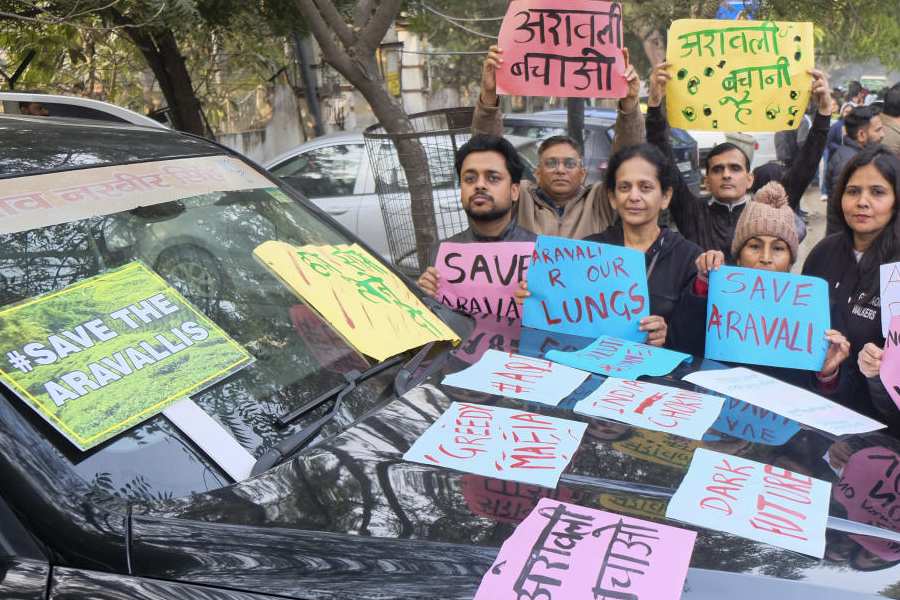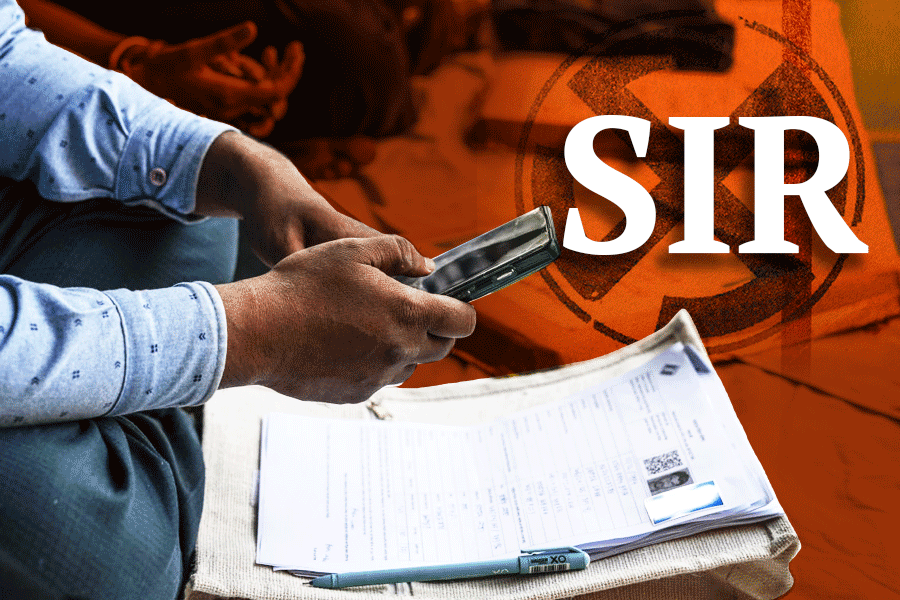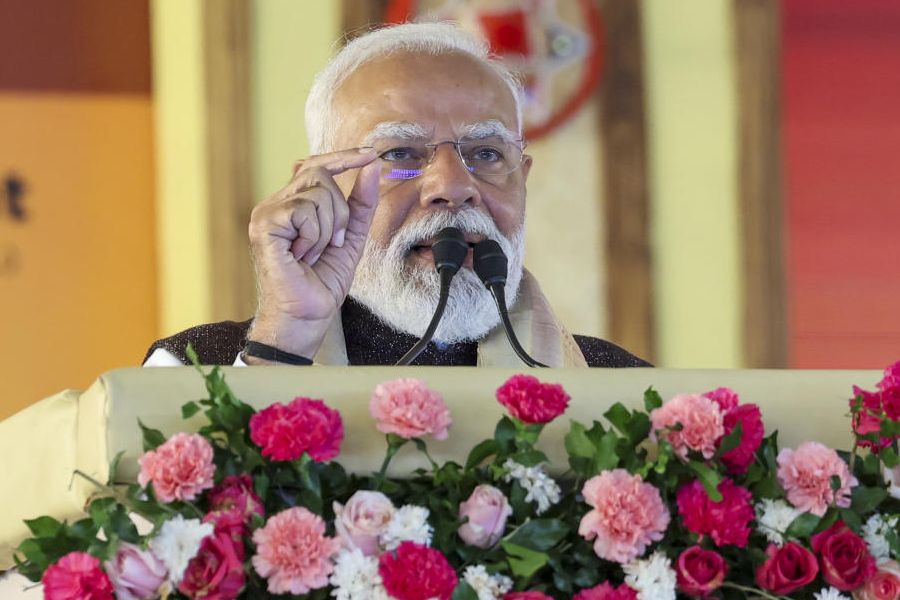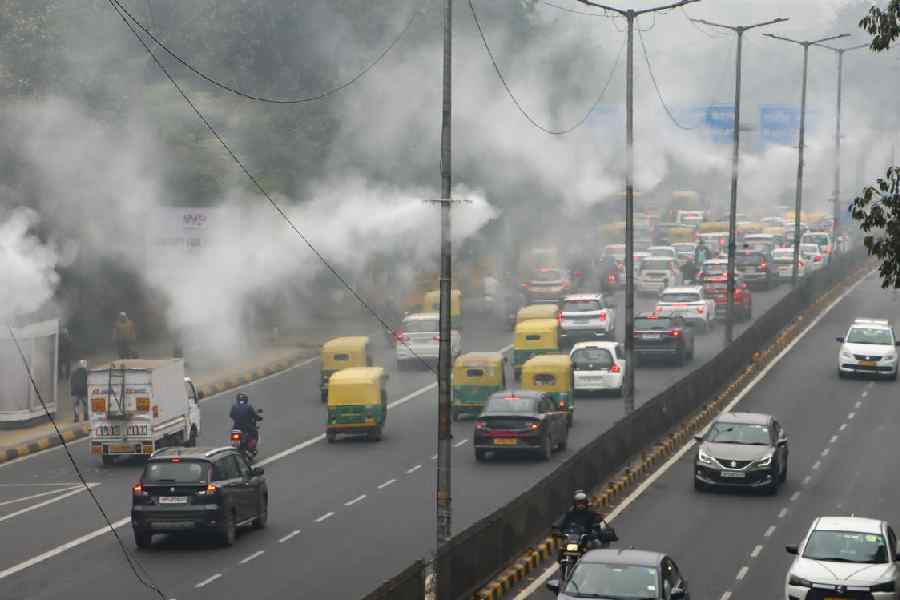.jpg)
The freedom gong sounded at day-end is one of the highpoints of any school day. At least that's how you remember it to be. It marks that Ulyssean moment when you can venture beyond structured existence and lay claim to the loot of childhood. It brings with it a lightness of being, so delightful, so seemingly unending that you think you'll vaporise from sheer happiness.
Rounds of city schools, however, tell a different story. In Calcutta, the gong seems to have lost not just its voice but its place in the young lives it shepherds.
Waiting outside a private school in Sodepur on the northern fringes of the city is a sea of parents, guardians, drivers and domestic helps. No sooner do their wards step outside the school gate than they scoop them up and hit the streets running.
The visual is scrambled. The children are at once eating, changing, walking, boarding cars, buses, rickshaws... "You cannot waste much time," says Smita Ghosh, mother of 13-year-old Shomit who is a student of Class VIII. "A minute's delay and you won't get a seat in the front row," she adds as she rushes off someplace. She has a bag in each hand and one more hanging from one shoulder. These contain food, small tetra packs of juice and lassi, and a change of clothes. School might be over, but the tuition countdown has begun.
Tuitions are not new but their centrality to the education system is. Never before have so many students, including middle and primary school-goers, attended private tuitions across India.
According to a 2014 report by the National Sample Survey Office, titled "Key Indicators of Social Consumption in India's Education", one out of every four students in the upper primary level (classes V-VIII) takes private tuitions. That's an estimated 71 million - around the same as the population of Madhya Pradesh. In West Bengal, the number is even higher than the national average - three out of five students attend private tuitions.
The story lies not just in the numbers but in the consolidation of a practice that in all likelihood caught on in the mid 1990s, post globalisation scenario. Pabitra Sarkar, former vice-chancellor of Calcutta's Rabindra Bharati University, has headed several education committees during the time of the Left Front government. He points out that this parallel system of education came to be prized by parents, especially "highly aspirational mothers" who wanted for their children skills they thought would be crucial to holding successful careers in a globalised economy.
Today, tuitions are no longer satellite arrangements revolving around the institution of the school. In fact, the larger sentiment is that the school gets in the way of tuitions, which have become the actual education dispensers. And this is true not only among upper and middle classes, but also in less-privileged families.
Ahona Mitra is Shomit's classmate. She and her mother, Sonali, are headed for the same Maths tutorial. It is a Thursday, one of the busiest days in the week for Ahona. Her day has started with a 6am Chemistry tuition, followed by English tuition. Her father has dropped her to the first, her mother picked her up from the second. Since the second tuition is some distance from the Mitras' apartment, they have worked out an arrangement with a relation who lives in the neighbourhood. After the tuitions, mother and daughter go over to this relation's house, shower, change, eat and get ready for school, which begins at 11. Isn't it much too exhausting for the child? " Ek deene onekta cover korle, onyo deengulo free thakey (If we can cover a lot of ground in one day, the rest of the days are relatively free)," says Sonali.
Indeed, because unlike those appearing for the boards, students of classes VII, VIII and IX still have to attend co-curricular classes - music, dance, swimming, skating.
"Private tuitions at the primary level is the highest in West Bengal, close to 75 per cent," says Achin Chakraborty, an economist who has extensively researched elementary education. He continues, "This is absurd. You won't see this anywhere in the world."
According to Chakraborty, the tuition mania is typical to Bengal and eastern India because there are not too many thriving industries or job options here. Parents feel students have to excel in academics to succeed. The pressure is way less in southern and western India, where there are more options and even entrepreneurship is a common and viable thing to do, often supported by the government.
Most students, Class VII upwards, attend tuitions for every subject - Science, Maths, English, Bengali, Computers. History and Geography, for some curious reason, are generally taught by the same person, which is fairly indicative of the callous attitude towards humanities subjects. Notes are the USP of the tuitions. Students whose parents are either not very educated themselves or are working, have a home tutor to curate and keep track of the notes or tuition literature from these six places. For subjects such as Maths, a child could be attending more than one tuition. Parents, especially mothers, are more than willing to bend backwards to cram all this frenetic activity into 24 hours.
In a 2014 paper titled "The Shadow School System and New Class Divisions in India", Manabi Majumder, a Political Science professor at the Centre for Studies in Social Sciences, Calcutta, cites case studies of parents buying or renting a second property in an area where their children can access a "reputed" school as well as a clutch of "successful" private tutors. Majumder's paper looks at Khardah, which is close to Sodepur. In different pockets of the city, largish halls with fans and attached toilets are rented out on an hourly basis. After school and before tuition class, guardians and children stop here to change, eat and catch a breath.
Shomit's Maths tuition is about 600 metres away from his school. He attends it twice a week for two hours after school. The tutor, Subhodeep Bose, has got the 750-square-foot apartment on rent. It can accommodate about 35 eighth-graders at one go. On weekdays Subhodeep teaches two to three batches alongside his day job at a private school. On Saturdays he teaches five batches all through the day. Smita gives you a Swot analysis on "Subhodeep Sir". "This setup is good. At Sumit Sir's, a smaller place, 50 children are packed in. He charges Rs 100 more than Subhodeep Sir, won't answer 'stupid' questions and can't be bothered to conduct mock tests."
But surely something gets done at school?
Monideepa Roy is 21. She has been home tutoring secondary school students ever since she cleared the Boards. She tells The Telegraph that at a rather well-known convent school in Salt Lake, the Maths teacher for Class V solves only the first two or three sums of every chapter. "Students are expected to copy them. There's no discussion, classwork or homework."
Sanghamitra Gupta, who used to teach English at Shri Shikshayatan previously and has being giving tuitions the last two years, has her sympathies with former colleagues. "It is not always possible for teachers to pay attention to every student, to explain each and every mistake." Please note, the class size at tuitions and schools are neck to neck. So the individual attention argument does not hold true of tuitions either.
According to Chakraborty, at one point, the State Council of Educational Research and Training attempted a survey to understand what it was with tuitions and the dependence on them. "The responses of guardians were nonsensical. They ranged from 'schools don't teach' to 'everyone goes so does my child'," he says.
Parents complain that schools have turned into organised crèches and the job of a teacher is to "mind" students. This is perhaps somewhat true of government schools, compounded further by CCL or child care leave introduced in 2015 by the West Bengal government. CCL allows women teachers with children under 18 years to avail nearly two years' leave. It has created too many vacancies; the student-teacher ratio has taken a beating, leaving teachers on duty with not much scope or energy but to mind the flock.
Educationist Pabitra Sarkar is not willing to accept that schools are at fault. He talks about the mistrust parents harbour for mainstream school education. Anjana Saha, principal of south Calcutta's Mahadevi Birla World Academy (MBWA), agrees. She says, despite organising a robust teaching system at MBWA, parents rush to tutorials. "They fall into the trap without even judging the quality of the tutors."
Smita is unmoved by these accusations. "I can't rely on school teaching." Shomit had developed Maths phobia in Class VII. "The teacher would get annoyed if Shomit asked questions or if he took time to wrap his head around something. I would be summoned and told my son is a slow learner."
Others argue that it is often a faked incompetence on the part of some schoolteachers to secure an alternate, better paid mode of income that drives students tuitionwards.
Teaching methodologies clash. One section of experts points out that tutors are not always up to date on the methodology required for the revised syllabii.
While every other aspect of this trend is up for debate, one thing is certain - schools have to act and act fast. In her paper, Manabi Majumder quotes a member of a secondary schoolteachers' union in Bengal as saying: "If and when tutorials are authorised to issue certificates, schools will certainly close down."
Majumder herself believes the education system needs to be rescued from the grip of "dulling drills", practised both in schools and at coaching centres. But she also adds that the "long-established tradition of supplementary tutoring would be hard to eliminate or ban altogether, although the Right to Education Act of India does ban such practices".
Some schools are stirring to action. Saha and her colleagues at MBWA have created a resource manual for students and guardians - a supplementary guideline on how to help the children study at home. "It's kind of a reading partnership with parents and children. Teachers stay back at school two days to interact with them. The target is to encourage students to focus on self-study." Just as well. Dual power centres are not desirable things as we know. Or do we?

.jpg)









